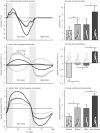Dynamic arm swinging in human walking
- PMID: 19640879
- PMCID: PMC2817299
- DOI: 10.1098/rspb.2009.0664
Dynamic arm swinging in human walking
Abstract
Humans tend to swing their arms when they walk, a curious behaviour since the arms play no obvious role in bipedal gait. It might be costly to use muscles to swing the arms, and it is unclear whether potential benefits elsewhere in the body would justify such costs. To examine these costs and benefits, we developed a passive dynamic walking model with free-swinging arms. Even with no torques driving the arms or legs, the model produced walking gaits with arm swinging similar to humans. Passive gaits with arm phasing opposite to normal were also found, but these induced a much greater reaction moment from the ground, which could require muscular effort in humans. We therefore hypothesized that the reduction of this moment may explain the physiological benefit of arm swinging. Experimental measurements of humans (n = 10) showed that normal arm swinging required minimal shoulder torque, while volitionally holding the arms still required 12 per cent more metabolic energy. Among measures of gait mechanics, vertical ground reaction moment was most affected by arm swinging and increased by 63 per cent without it. Walking with opposite-to-normal arm phasing required minimal shoulder effort but magnified the ground reaction moment, causing metabolic rate to increase by 26 per cent. Passive dynamics appear to make arm swinging easy, while indirect benefits from reduced vertical moments make it worthwhile overall.
Figures






Similar articles
-
The how and why of arm swing during human walking.Gait Posture. 2013 Sep;38(4):555-62. doi: 10.1016/j.gaitpost.2013.02.006. Epub 2013 Mar 13. Gait Posture. 2013. PMID: 23489950 Review.
-
A low-cost method for carrying loads during human walking.J Exp Biol. 2020 Dec 4;223(Pt 23):jeb216119. doi: 10.1242/jeb.216119. J Exp Biol. 2020. PMID: 33106297
-
The metabolic cost of human running: is swinging the arms worth it?J Exp Biol. 2014 Jul 15;217(Pt 14):2456-61. doi: 10.1242/jeb.100420. J Exp Biol. 2014. PMID: 25031455
-
Activity of upper limb muscles during human walking.J Electromyogr Kinesiol. 2012 Apr;22(2):199-206. doi: 10.1016/j.jelekin.2011.08.014. Epub 2011 Sep 25. J Electromyogr Kinesiol. 2012. PMID: 21945656
-
Contributions to the understanding of gait control.Dan Med J. 2014 Apr;61(4):B4823. Dan Med J. 2014. PMID: 24814597 Review.
Cited by
-
Daily acute intermittent hypoxia combined with walking practice enhances walking performance but not intralimb motor coordination in persons with chronic incomplete spinal cord injury.Exp Neurol. 2021 Jun;340:113669. doi: 10.1016/j.expneurol.2021.113669. Epub 2021 Feb 27. Exp Neurol. 2021. PMID: 33647273 Free PMC article. Clinical Trial.
-
Modelling strategies supplemental to foot placement for frontal-plane stability in walking.J R Soc Interface. 2024 Sep;21(218):20240191. doi: 10.1098/rsif.2024.0191. Epub 2024 Sep 4. J R Soc Interface. 2024. PMID: 39226925
-
Lateralized modulation of cortical beta power during human gait is related to arm swing.iScience. 2024 Jun 17;27(7):110301. doi: 10.1016/j.isci.2024.110301. eCollection 2024 Jul 19. iScience. 2024. PMID: 39055930 Free PMC article.
-
Influence of arm swing on cost of transport during walking.Biol Open. 2019 Jun 10;8(6):bio039263. doi: 10.1242/bio.039263. Biol Open. 2019. PMID: 31142466 Free PMC article.
-
Self-selected step length asymmetry is not explained by energy cost minimization in individuals with chronic stroke.J Neuroeng Rehabil. 2020 Aug 26;17(1):119. doi: 10.1186/s12984-020-00733-y. J Neuroeng Rehabil. 2020. PMID: 32847596 Free PMC article.
References
-
- Brockway J. M.1987Derivation of formulae used to calculate energy expenditure in man. Hum. Nutr. Clin. Nutr. 41, 463–471 - PubMed
-
- Bruijn S. M., Meijer O. G., van Dieën J. H., Kingma I., Lamoth C. J. C.2008Coordination of leg swing, thorax rotations, and pelvis rotations during gait: the organisation of total body angular momentum. Gait Posture 27, 455–462 (doi:10.1016/j.gaitpost.2007.05.017) - DOI - PubMed
-
- Collins S. H., Wisse M., Ruina A.2001A 3-D passive dynamic walking robot with two legs and knees. Int. J. Robot. Res. 20, 607–615 (doi:10.1177/02783640122067561) - DOI
-
- Collins S., Ruina R., Tedrake R., Wisse M.2005Efficient bipedal robots based on passive–dynamic walkers. Science 307, 1082–1085 (doi:10.1126/science.1107799) - DOI - PubMed
-
- Collins S. H., Adamczyk P. G., Kuo A. D.2009A simple method for calibrating force plates and force treadmills using an instrumented pole. Gait Posture 29, 59–64 (doi:10.1016/j.gaitpost.2008.06.010) - DOI - PMC - PubMed
Publication types
MeSH terms
Grants and funding
LinkOut - more resources
Full Text Sources
Other Literature Sources
Medical

